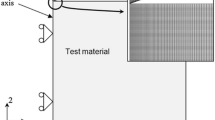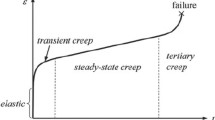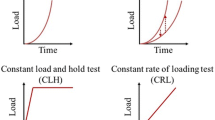Abstract
The possibilities of determining creep parameters for a simple Norton law material are explored from indentation creep testing. Using creep finite element analysis the creep indentation test technique is analyzed in terms of indentation rates at constant loads. Emphasis is placed on the relationships between the steady creep behavior of indentation systems and the creep property of the indented materials. The role of indenter geometry, size effects and macroscopic constraints is explicitly considered on indentation creep experiments. The influence of macroscopic constraints from the material systems becomes important when the size of the indenter is of the same order of magnitude as the size of the testing material. Two methods have been presented to assess the creep property of the indented material from the indentation experimental results on the single-phase-material and two-phase-material systems. The results contribute to a better mechanical understanding and extending the application of indentation creep testing.
Similar content being viewed by others
References
Webster G A, Ainsworth R A.High Temperature Component Life Assessment[M]. London: Chapman & Hall, 1994.
Cadek J.Creep in Metallic Materials[M]. Amsterdam: Elsevier, 1988.
Nabarro F R N, de Villiers H L.The Physics of Creep[M]. London: Taylor and Francis, 1995.
Evans B, Indentation testing[J].J Geophys Res, 1984,89(10):4213–4222.
Li W B, Henshall J L, Hooper R M,et al. The mechanism of Indentation creep[J].Acta Metall Mater, 1991,39(8):3099–3109.
Pandorf R, Broeckmann C, Berns H. Indentationskriechen[J].MP Materialprüfung, 1999,41(2):294–300.
Li J C M, Creep of Sn−Pb eutectic alloy[A]. In: J C Earthman, F A Mohamed Eds.Proceedings of the seventh international conference on creep and fracture of engineering materials and structures: The Minerals, Metals & Materials Society[C]. Warrendale, 1997, 109–117.
Lucas B N, Oliver W C. Indentation power-law creep of high-purity indium[J].Metallurgical and Materials Transactions, 1999,30A(3):601–610.
Becker A A, Hyde T H, Xia L. Numerical analysis of creep in components[J].J Strain Analysis, 1994,29(3):27–34.
Hyde T H, Yehia K A, Becker A A. Application of the reference stress method for interpreting impression creep test data[J].Materials at High Temperatures, 1995,13(3):133–137.
Dieter G E.Mechanical Metallurgy[M]. New York: McGraw-Hill Book Company, 1988.
Hibbit, Karlsson, Sorensen. ABAQUS User's Manual[M]. Version 5.6, 1988.
Author information
Authors and Affiliations
Additional information
Communicated by ZHENG Quan-shui
Foundation item: the National Natural Science Foundation of China (50005016)
Biography: YUE Zhu-feng (1965-)
Rights and permissions
About this article
Cite this article
Zhu-feng, Y., Jian-song, W. & Zhen-zhou, L. Determination of creep parameters from indentation creep experiments. Appl Math Mech 24, 307–317 (2003). https://doi.org/10.1007/BF02438268
Received:
Revised:
Issue Date:
DOI: https://doi.org/10.1007/BF02438268
Key words
- indentation creep testing
- finite element creep stress analysis
- determination of creep parameters
- single-phase-material system
- two-phase-material system




